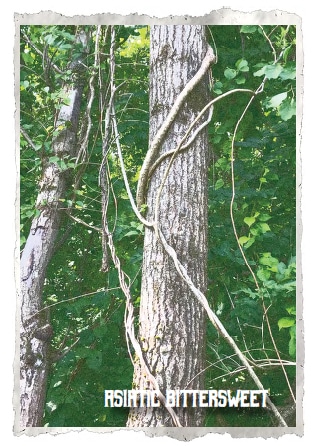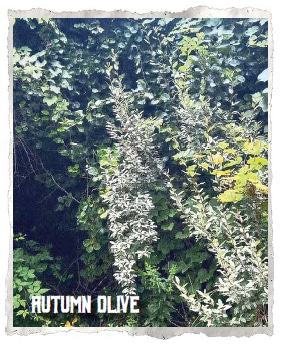Written by David Johnson
It’s a dark night. The third quarter moon illuminates wisps of clouds that swirl overhead. Wind whips through the tree branches overhead, which creak and groan as you make your way through the woods.
With each spectral howl, you shiver, and the hairs on your arm prick up. But that’s not what sends a chill down your spine. No, it’s something else. Something more primal. It’s a feeling you can’t shake – an intruder is lurking.
And that’s when you see it! When the clouds move ever so briefly and moonlight peeks out and casts an ethereal glow on a startling tableau before you. It is a tree, and it is draped in...Asiatic bittersweet!
 When it comes to invasive plants, it is tempting to conjure forth a colorful metaphor like “doing battle with” or “waging war against” the encroachment of this unwelcome vegetation. But Malin Clyde, SELT Board member and University of New Hampshire Cooperative Extension Specialist in Natural Resources, recoils at such language. Because she knows. She can’t unsee what she has seen over her years of grappling with a variety of vegetative vagabonds.
When it comes to invasive plants, it is tempting to conjure forth a colorful metaphor like “doing battle with” or “waging war against” the encroachment of this unwelcome vegetation. But Malin Clyde, SELT Board member and University of New Hampshire Cooperative Extension Specialist in Natural Resources, recoils at such language. Because she knows. She can’t unsee what she has seen over her years of grappling with a variety of vegetative vagabonds.
“I don’t like to use a war analogy, because, frankly, this is a war that is not winnable,” she says. “The tough thing about invasive plants is that once you learn a little bit about them and what they look like, it can become depressing because they are everywhere. I can go for a walk or run and glance at the side of the road and see them. I go through this every day!”
Malin recounts this experience not with a tone of cynicism, but sober reality (and, sure, maybe a hint of melancholy). Because, when you get right down to it, invasive plants are a part of the New Hampshire ecosystem – and they are, after all, plants – seed-spreading sprouts and stems that do precisely what their chloroplasts are telling them to do: go forth and multiply.
It’s not like they asked to be transported overseas and deposited in North America. Plants can’t ask for anything anyway. (They don’t have mouths.)
So, what exactly do we mean when we talk about invasive plants? From our friends at New Hampshire Fish and Game, a definition:
“A plant species is termed ‘invasive’ when it is not native to the region and is likely to cause economic or environmental harm. A plant does not have to come from another country to be considered invasive. It can beany plant introduced outside its historical range that out-competes native species.”
How does this visiting team outperform the home team, especially on its home court? Research has shown that these interlopers have arrived on our shores with a distinct advantage: the predators that had kept them in check at their native locales are absent here, giving them a significant evolutionary advantage once they get down to business in New England.
The eco-deck is, alas, stacked against the New Hampshire indigenous plant life and once invasives take root and spread, restoration back to the original state would require a resource investment of Manhattan Project-level proportions.
Is all lost? No! The conflict with invasives requires 1) prevention, 2) people power, and 3) patience.
Prevention
Get in early and identify the property you want to preserve! Is it farmland that will be used for grazing or a forest that attracts outdoor recreation enthusiasts? Stay on the lookout and get in the mindset for early detection, so that if and when an invasive makes its presence known, an offensive game plan can be implemented before the property is overrun.
“What are our most special property features that we want to conserve?” Malin says. “Let’s look at the places that are in great shape, so that we can head the invasives off at the pass.”
People Power
When the Bat Signal goes out and an invasive has been spotted at one of these preferred properties and it’s time to spring into action, you’ll need a committed group of folks who have the will and the horsepower to get outside and spend the day with their hands in the dirt pulling weeds.
SELT relies on its incredible group of volunteers to help carry out these projects; look no further than the workdays that have happened at SELT’s Burley Farms in Epping, where volunteers spent hours rooting out a spotted knapweed incursion, an offensive that is geared towards preserving the land for future farm use.
“The key is to get more people involved in early detection,” Malin says. “It’s good from an ecological perspective and great for engaging the public. Plus, it’s really exciting for people to feel like they’re making a difference.”
 Patience
Patience
The invasives issue is simply a way of life, and there is no easy solution or miracle cure; it is an infection without an antidote. But despair has no quarter here, and being tactical, purposeful, and above all, patient, is the route to take to keep those special properties diverse and thriving.
“Land conservation is all about taking the long view,” Malin says. “When you come in with that perspective and you know where you’re headed, you can make progress. That’s stewardship.”

 Patience
Patience